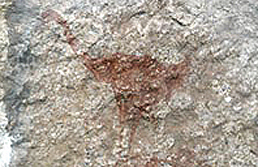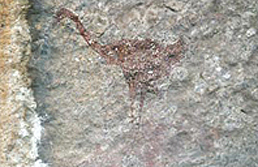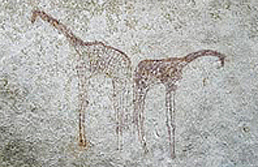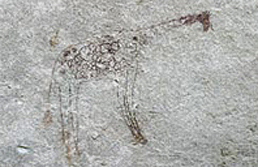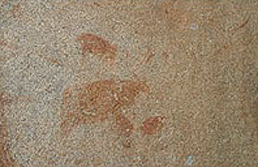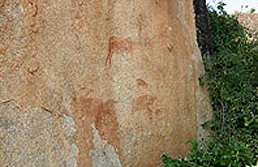 |
 |
Nkinto |
Site 19 |
Singida Region / Iramba District / Kisiriri Division
Kinto is a small village some 4km southeast of Isanzu Mission. The Kinto site is therefore named after the village of the same name. It features an exterior cave with very large openings on the east and west side. On the north side of the western end and the lower part of the overhang is a representation of an ostrich and beside it are near spherical drawings which have been interpreted as the ostrich’s eggs. Birds are as a general rule not a popular subject matter in central Tanzania. The spherical drawings appear to be in a nest. All the pictographs have been executed either in scarlet or light ocherous red. In some sites, the lighter shade seems to overlie the scarlet one where the two pigments overlap. The same site was studied by Ludwig and Margrit Kohl-Larsen in 1936-38. They also excavated the site and found LSA deposits of Wilton nature. They referred to the site as Mkirampirewand (Kohl-Larsen 1958: 52-53). The site was in a reasonably good state of preservation in 1995, but when it was visited in June 2003, it had depreciated considerably.
 |
 |
Ntwiga |
Site 20 |
Singida Region / Iramba District / Kinyangiri Division
As the code suggests, this site is in the division of Kinyangiri. It is also near the village of Ishenga. The site is located on the southern slopes of Ntwiga hill, which overlooks the village of Ishenga. The hill apparently received the name from the site, which is popularly known for its paintings of giraffes.
There are three giraffes all done in somewhat different styles. All are executed in ocherous red, but two of them have their hind parts abutting each other. One is infilled with squares and checkers while the other is infilled with blotches and lines - or as M.D. Leakey (1983) would have it, geometric streaky. The third is infilled with reticulate.
It is however suspected that these paintings are much later than either the red or white ashy paintings found in other sites because:
| ● |
They are less naturalistic than giraffes in other sites done in the same pigment. |
| ● |
The tail is depicted in a new style; i.e. having tassels at the tip. |
| ● |
The feet lack hooves. |
| ● |
The paintings are very fresh, as if they were painted a few months ago. |
| ● |
Unlike many other sites, which have a habitable floor, this one does not seem to be associated with archaeological deposits. |
Yet all these observations do not make it any easier to assess the cultural and historical significance of the site. If anything, they make the situation even more baffling. An old man by the name of Ali Hasan, aged about 65 years old, who now lives in Iambi, claimed that when he was a boy, his grandfather told him about the paintings. Being perhaps of the same age then as he was when I interviewed him, his grandfather claimed he did not know when the paintings were executed and that when he grew up as a child, the paintiings were already there. This story would make the paintings at least 120 years. The site is in a very good state of preservation, but like many other painted rock shelters, it has been affected by cave robbers.
 |
 |
Ntwiga 2 |
Site 21 |
Singida Region / Iramba District / Kinyangiri Division
This is a straight-sided inselberg on the southern part of Ntwiga ridge. The painted area faces north. The subject matter includes animals such as elands, giraffes, elephants, baboon-like and lion-like animals. There are also humans with arrows. All these are done in ocherous red pigment, the animals being naturalistic silhouettes while the anthropomorphics are stylised. Although there are instances of superpositioning, the sequence is difficult to establish especially when there is little time to spend on any one site. Distinguishing the sequence was also made difficult because the shades of red pigment used are very similar. The floor was littered with recent potsherds, but unlike the previous site, it seems, at least from the dirt excavated by cave robbers, to be archaeologically stratified. Also around the site were found artifacts of LSA nature. The site was considered to be in a good state of preservation.
→
Rock Art in Tanzania
→
Tanzania Rock Art - Forward by Dr. Meave Leakey
→
Overview of Tanzania Rock Art Sites
→
Tanzania Conservation & Management
→
Tanzania Rock Art Sites|
1-2 |
3-6 |
7-9 |
10-12 |
13-14 |
15-16 |
17-18 |
19-21 |
22-24 |
25-26 |
→
Africa Rock Art Archive
→
Bradshaw Foundation
Like us on Facebook & Follow us on Twitter to receive news & updates:
